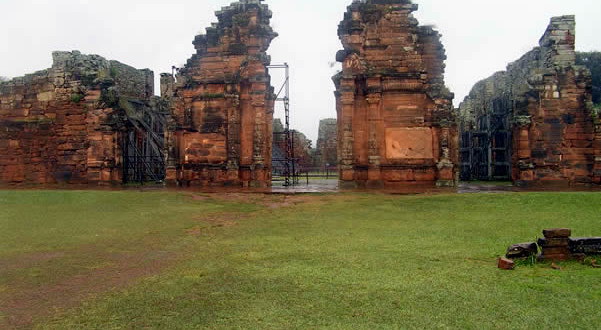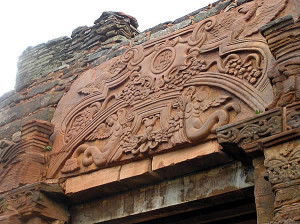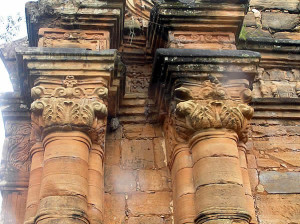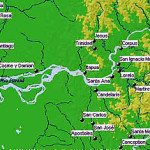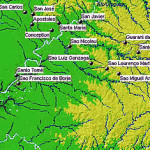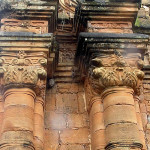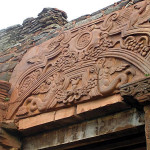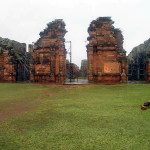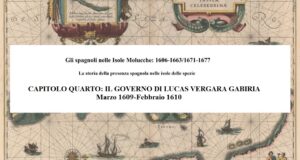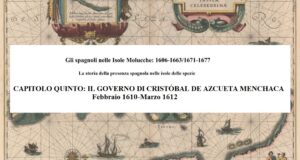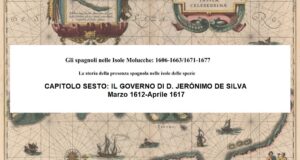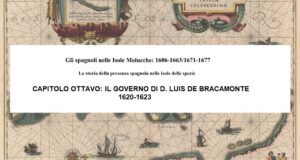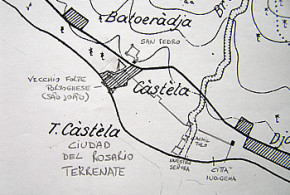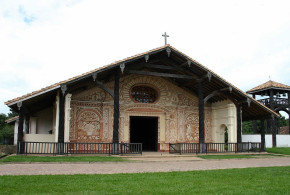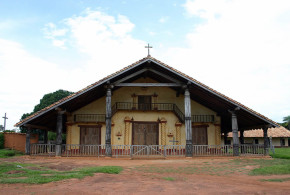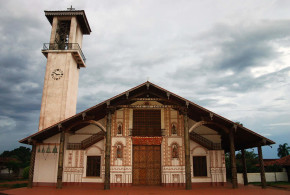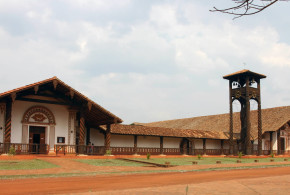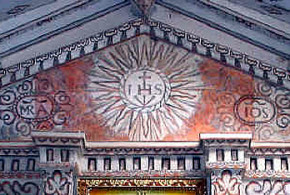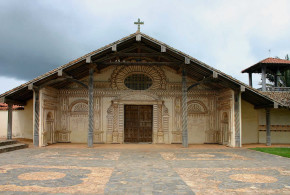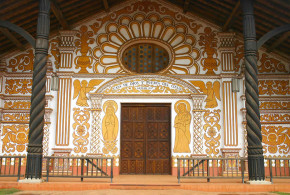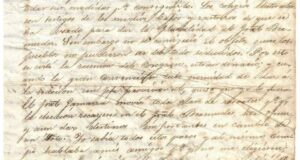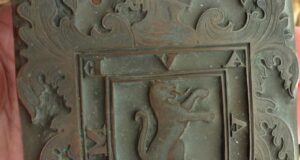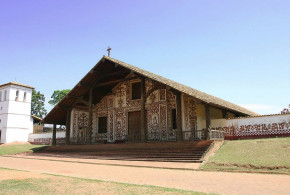Written by Marco Ramerini. English text revision by Geoffrey A. P. Groesbeck
The Indios Guaraní of Paraguay, Argentina and Brazil would have been another indigenous people victim of the colonial conquest in South America, if the Jesuits would haven’t been able to persuade the King of Spain to grant that vast region to their care.
The Jesuits promised to the King generous rewards, in the form of tributes, in exchange of the exemption from the “encomiendas” (hard labour to which were subjected all the other Indios), assuring that the region would have been an Imperial dominion thanks only to the Gospel power.
Therefore, for about 150 years, the Jesuits succeeded in protecting the Guaraní from the raids of the slave-hunters from São Paulo (Paulistas). They founded several missions or “reducciones” and developed a kind of evangelisation a bit peculiar for that time. They put into practice the precepts of the Gospel, isolated the Guaraní from the bad influences of the Europeans and developed the creativity of the Indios.
The Jesuits, in the 17th and 18th Centuries, achieved this bold experiment in religious colonisation. The Reducciones encompassed the vast zone of today’s Argentina, Paraguay, southern Brazil and Uruguay. They were one of the most singular creations of the Catholic missionary activity.
The first settlement had founded in 1609. Many other Jesuit Missions were established along the rivers, in the Chaco, Guaira and Paraná territories. The first missions were founded in Brazil, but due to the continuous raids of the Paulistas, were soon abandoned (1640s.).
Guided by the Jesuits, the Indios had advanced laws, they founded free public services for the poor, schools, hospitals, established birth control, and suppressed the death penalty. A kind of society based on the principles of the primitive Christianity had been established. All the inhabitants of the “reducciones” worked in the “tupambae”, land property of the community, and all the products which they produced were fairly divided among them.
The Guaraní were very skilled in handicraft works, sculpture, woodcarving etc.; the “reducciones”, were the first “industrial” state of the South America. Indeed, such advanced products as watches, musical instruments, etc. were produced in the “reducciones”. The first typography of the New World had been built in the reducciones. The working day was about 6 hours (in Europe at that time was of 12-14 hours), and the free time had been dedicated to music, dance, bow-shot contests and to prayer. The Guaraní society was the first in history of the world to be entirely literate.
The main settlements had been on the Rio Paraná along the border of the present Argentina and Paraguay. These missions reached their apogee in the first half of 18th century, gathered around about 30 missions, between 100.000 and 300.000 Indios converted to Catholicism.
The Jesuit missions assumed almost full independence, as if they were real nations. The “reducciones” were centres of the community life. The main buildings, like the church, the college, the church yard were concentrated around a wide square. The Indios’ houses were faced on the other three sides of the square. The village was also provided with a house for the widows, a hospital, and several warehouses. In the centre of the square, rose on a tall base, remained a huge cross and the patron Saint statue, for which the mission was named. Some “reducciones” numbered up to 20.000 inhabitants.
Trouble started in 1750s, when the King of Spain ceded to Portugal a portion of the territory where the missions were located. The Portuguese, who wanted to take economic advantage of these zones and of the work of the Indios, caused the so-called Guaraní wars which concluded in 1756 with the Indios defeat. The Jesuit Missions ended in 1767, with the expulsion of the Jesuits. During that time, the last missions also emptied and the Indios returned in the forest.
Today, of that time, are left the beautiful ruins of some of the “reducciones”, and the indigenous language: the Guaraní, that is today the only native language to be the official language of a South American nation: Paraguay. The Indios Guaraní almost disappeared as they are now, reduced to only 50.000 people. The remains of the reducciones, are one of the most interesting chapters of the colonial history, with some of the most remarkable examples of art of the 17th. and 18th. centuries in South America.
- Map of the Guaranì Jesuitical Missions "Reducciones" in Argentina and Paraguay. Author Marco Ramerini
- Map of the Guaranì Jesuitical Missions "Reducciones" in Brazil and Argentina. Author Marco Ramerini
The ruins of 8 missions are in Paraguay:
San Ignacio Guazù (1609)
Santa Rosa de Lima (1698)
Santa Maria da Fé (1647)
San Cosme y Damian (1652) it had also an astronomic observatory.
Santiago (1651)
Itapua today Encarnacion.
Jesus de Tavarangué (1685) UNESCO world heritage.
Santissima Trinidad de Paranà (1706) UNESCO world heritage.
The ruins of 15 missions are in Argentina:
San Ignacio Mini (1632) UNESCO world heritage.
Santa Ana (1637) UNESCO world heritage.
Nuestra Senhora de Loreto UNESCO world heritage.
Santa Maria la Major UNESCO world heritage.
Candelaria, Corpus, San Carlos, San José, Martires, San Javier, Conception, Apostoles, Santo Tomé, Yapeiu, La Cruz.
The ruins of 7 missions are in Brazil:
Sao Miguel Arcanjo (das Missoes) (1687) the chief mission of the seven in Brazil that is a UNESCO world heritage site. Close there were the missions of Santo Angelo (1706), Sao Francisco de Borja (1682), Sao Nicolau, Sao Luiz Gonzaga, Sao Lourenço Martir (1690), Sao Joao Batista (1697).
Chiquitos missions (Bolivia):
San Francisco Javier, Conception, Santa Ana, San Miguel, San Rafael, San José. UNESCO world heritage site.
Taruma missions:
Between the Guaranì e Chiquitos missions, there were the missions of Taruma: Sao Joaquin (1747), San Estanislao (1747), Belen (1760).
- San Ignacio Miní, Misiones, Argentina. Author and Copyright Marco Ramerini.
- San Ignacio Miní, Misiones, Argentina. Author and Copyright Marco Ramerini.
- San Ignacio Miní, Misiones, Argentina. Author and Copyright Marco Ramerini.
BIBLIOGRAPHY:
– Caraman, Philip “The lost paradise: the Jesuit Republic in South America” 1976, New York: Seabury Press
– Gomez, Alcide Antonio “Ruinas Jesuiticas de San Ignacio Mini. Los treinte pueblos” San Ignacio Mini, Argentina
– Cunninghame Graham, R.B. “A Vanished Arcadia: Being Some Account of the Jesuits in Paraguay 1607 to 1767” 1924, London, William Heinemann
– Ganson, Barbara “The Guarani under Spanish Rule in the Rio de la Plata” 2003, Stanford University Press
– Gomez, Alcide Antonio “Ruinas Jesuiticas de San Ignacio Mini. Los treinte pueblos” San Ignacio Mini, Argentina
 Colonial Voyage The website dedicated to the Colonial History
Colonial Voyage The website dedicated to the Colonial History
